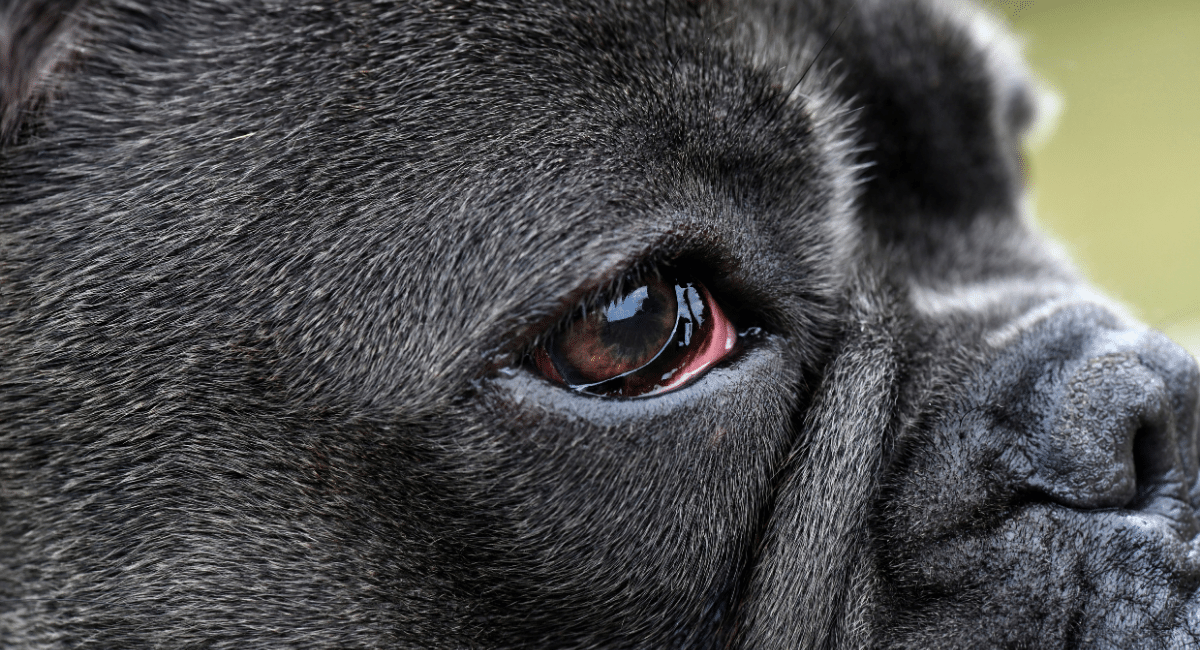What's the Reason Behind Your Dog's Goopy, Red Eyes: Signs, Causes, and Treatments
Dog eye infections can happen to any happy pup. Whether they are triggered by grit or grass stuck under their eyelids, recurring seasonal allergies or any other pesky culprit, these infections can cause your dog a lot of discomfort.
As a dog owner, you may feel a little worried upon seeing your furry best friend’s goopy red eyes; after all, you want to ensure they remain in the best of health. In moments like this, it’s important for you to understand the signs, symptoms and causes behind the inflammation in order to get the right treatment.
Consider this blog as a Dog Eye Infection 101 where you’ll discover essential information that will guide you along the right path to restoring your dog’s eyes to perfect health.
How Serious Is A Dog Eye Infection?
If your dog experiences some eye-irritation caused by substances like dust, smoke, or even shampoo, it is likely that there isn’t a major cause for alarm. Typically, removing the irritant and wiping their watery eyes with a saline solution will do the trick to bring them fast relief.
In other instances where the inflammation is triggered by bacteria, the use of antibiotics can be a simple yet effective cure.
However, if you’ve tried these remedies and your canine pal is still in pain, producing consistent eye boogers, or experiencing swelling of the eyelids and redness in the white of the eyes, there could be a serious underlying health complication that requires emergency veterinary attention. For severe cases, when left untreated, the eye infection can spread or result in vision loss.
This is why it is so important to know the common signs and symptoms behind dog-eye infections so that you can identify the possible causes and take the right course of treatment to ensure your pet’s eye health can be restored.
How to Tell If a Dog has an Eye Infection: Signs & Symptoms
If only your best buddy could verbally tell you how they feel - it would be a thousand times easier to recognize and treat the infection. Unfortunately, they can’t talk like humans do and, as such, you must be on the lookout for signs that they aren’t feeling themselves. Luckily, the symptoms of an eye infection are easy to spot.
If your pet exhibits one or more of the following symptoms for more than a few days, they may likely be suffering with an eye infection:
- Weepy or Watery Eyes –Your dog may appear as though they’re crying.
- Redness – The white of your pup’s eyes may turn red.
- Goopy or Crusty Eyes – Eye boogers that consist of mucus, dust, dried tears and other irritants may gather at the corner of their eyelids or even cover their eyes.
- Yellow, Greenish or Greyish Discharge – The eye discharge will gather at the corner of their eyes.
- Light Sensitivity – Your dog may hide and avoid being in lit rooms.
- Pawing at the Eye – The pain may cause your dog to excessively rub their eyes with their paws.
- Constant Squinting or Blinking – This is another indicator that your pet may be in pain.
What’s Causing Your Dog’s Watery Goopy Eyes and How to Treat It?
Just like humans, the causes of dog-eye infections are numerous. In addition to allergies and foreign matter in the eyes, some other common causes of dog-eye infections include the following:
1. Conjunctivitis or Pink Eye
Conjunctivitis, one of the most common canine eye disorders, is a condition in which the pink tissue inside your dog’s eyelid (called the conjunctiva) becomes inflamed.
If you witness mucus, pus, or a yellowish-green discharge lining your dog’s eyes, or the eyes are noticeably inflamed, there is a possibility that they may be suffering from conjunctivitis. You may also see them blinking excessively or pawing away at the eyes.
It’s not so simple to attach a definite cause to conjunctivitis because there can be multiple reasons - for example, tear duct defects, dog distemper, allergies, injuries, tumors, or perhaps just irritants like dust or an eyelash.
Sometimes, a dog may contract a contagious viral or bacterial form of conjunctivitis. To be safe, once you notice your dog has an eye-infection, keep him away from the other pets to avoid spread.
Conventional Treatment for Conjunctivitis
The right treatment to tackle conjunctivitis is dependent on the cause. However, it may include removing the irritant or allergen, antibiotics, saline washes, surgery or homeopathic remedies. If you suspect your dog has conjunctivitis, it will be a good idea to take them to a vet to uncover the root of the issue.
2. Dry-Eye
Dry-eye is when your dog is unable to produce enough eye-cleansing tears. Generally, this condition is signaled by a sticky, persistent eye discharge along with a build-up of mucus, constant squinting and red eyes.
Similarly to Conjunctivitis, its causes can vary from a blow to their head near the tear duct or distemper. However, according to TheWildest.com, dry eye is most commonly caused by an immune-related problem that creates inflammation within the tear glands and reduces the amount or quality of the tears your dog produces.
Conventional Treatment for Dry Eye
Even though there is no cure for dry-eye, it is a condition that can be managed. The course of treatment is also dependent on the severity of the case.
For mild cases, a vet may administer artificial tears over several weeks.
For more severe cases, immunosuppressants may be used or surgery may be recommended.
3. Epiphora
Epiphora occurs when the tear ducts of your dog become blocked due to allergies, conjunctivitis, irritants, abnormal tear drainage, and other serious conditions like corneal ulcers or tumors.
When your four-legged companion is battling Epiphora, you may notice the following symptoms:
- Reddish-brown stains under the eyes and near the nose
- Constant wetness around the eyes
- Crust around the eyes
- Swollen eyelids and face
- Excessive blinking and squinting (due to pain)
- Rubbing eyes and face
- Red and or cloudy eyes
If based on the symptoms above, you suspect that your dog may have Epiphora, take them to a veterinarian right away!
Conventional Treatments for Epiphora
The culprit behind the occurrence of Epiphora will be a major factor that determines the kind of treatment given to your dog. However, medication is often first prescribed to clean the reddish-brown stains. If it is triggered by a bacterium, antibiotics will be administered. Surgery may also be suggested to repair the tear ducts or remove the blockage.
Epiphora can be quite painful for your dog; while you await medical attention, give your pet some relief by creating a warm compress with sterile water and placing it over their eyes.
Breed Physiological Tendencies
The physiology of a dog’s breed can make them more susceptible to health problems, including eye infections. The following types of dog breeds have a greater likelihood to contract an eye infection:
Flat-Faced Dogs (Brachycephalic Breeds)
Dogs belonging to this group: Bulldogs, Boxers, Boston Terriers, Pugs, Pekingese
Cause for Increased Susceptibility: Shallow eye-sockets and protruding eyes characterize this group. Dogs with more bulging eyes have a tendency to have tear duct drainage complications. Their eyelids also roll inward, causing irritation by the lashes. In some unfortunate cases, their lids don’t fully close over their eyes; surgery is often required to correct this defect.
Dogs with Loose Facial Skin
Dogs belonging to this group: Cocker Spaniels, Saint Bernard, Mastiffs, some Terriers and Bloodhounds.
Cause for Increased Susceptibility: Dogs with loose facial skin are more prone to having eyelids that roll outward. This causes a condition called Cherry-Eye where the gland in the eyelid falls out of position. Surgery is also often necessary for these conditions.
How to Treat Dog-Eye Infections At Home Naturally
It’s understandable that sometimes it’s just not practical for you to take Fido to the vet right away. As an alternative, you can provide relief to your pet right in the comfort of your own home. However, home note that remedies may be only a short-term solution.
If you’re seeing clear white discharge with little redness, you can also use a warm, moist towel to gently clean discharge from the corners of your dog’s eyes. A saline rinse made from the recipe below can also help:
What You'll Need:
- ¼ teaspoon of salt
- 1 cup of lukewarm water
- Cotton balls
Directions:
- Mix salt with lukewarm water
- Soak the cotton ball in the solution for a few seconds
- Squeeze most of the solution from the cotton ball so that it does not drip
- Wipe the edges of the eyelids and remove any crusty build-up present
Every dog is unique, so this solution may not help all dogs with inflammation or an eye infection. You may also want to try using chamomile tea, Aloe Vera gel, or colloidal silver to wipe your pet's eyes - see this article for more information.
If something is stuck in their eyes and the debris or substance can be removed easily without inflicting pain on your pet, then feel free to remove it yourself. However, if it’s something larger, it’s recommended that you take your fur pal to the vet.
Try our All-Natural Holistic Remedy Designed Specifically for Dog Eye Infections
Using a unique homeopathic formula of powerful naturally occurring ingredients, our Vision and Eye Care support is carefully designed to heal your dog’s eye-infection and provide quick relief from its associated symptoms such as watery red eyes, conjunctivitis, burning, itching, pain and even blurred vision.
Our unique blend treats eye discharge and inflammation caused by a variety of issues including: fungus, environmental toxins, abnormal eyelashes, Conjunctivitis or pink eye, inflammation of the cornea or internal structure of the eye, nerve damage, and even allergies.
Give it a try here: BestLife4Pets Vision Support for Dogs
Though dog-eye infections can happen to any dog, it’s important to keep your friend happy and healthy with routine eye care checks at the vet.
We wish your sweet pup the best of health!



